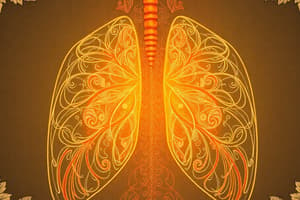Podcast
Questions and Answers
What is the primary function of the diaphragm during breathing?
What is the primary function of the diaphragm during breathing?
- To assist in airflow regulation from the lungs (correct)
- To produce vocal sounds directly
- To expand the rib cage while inhaling
- To shape the vocal folds for higher pitch
Which posture element is NOT mentioned as essential for singing?
Which posture element is NOT mentioned as essential for singing?
- Feet slightly apart
- Shoulders down and back
- Spine aligned and relaxed
- Head tilted to the side (correct)
What does the term 'dynamics' specifically refer to in singing?
What does the term 'dynamics' specifically refer to in singing?
- The tempo changes throughout the melody
- The variation in pitch during a song
- The rhythmical patterns of singing
- The loudness and softness of vocal sounds (correct)
Which aspect does NOT contribute to the tone quality of a singer's voice?
Which aspect does NOT contribute to the tone quality of a singer's voice?
Which of the following words best describes a vocal tone that is light and airy?
Which of the following words best describes a vocal tone that is light and airy?
Which of the following is NOT considered an optimal vocal tone?
Which of the following is NOT considered an optimal vocal tone?
What component of singing is primarily responsible for creating sound waves?
What component of singing is primarily responsible for creating sound waves?
Poor diction may result from which of the following factors?
Poor diction may result from which of the following factors?
Which aspect of diction influences how words are grouped and connected in singing?
Which aspect of diction influences how words are grouped and connected in singing?
What do vowels in singing primarily depend on?
What do vowels in singing primarily depend on?
Flashcards are hidden until you start studying
Study Notes
Breathing and Vocal Production
- Breathing is essential for singing.
- The diaphragm is the main muscle used in breathing.
- It contracts during inhalation, flattening and expanding the chest cavity, creating a vacuum that pulls air into the lungs.
- During exhalation, the diaphragm relaxes, returning to its dome shape, forcing air out of the lungs.
- Airflow from the lungs vibrates the vocal folds, producing sound.
Posture for Singing
- Proper posture is crucial for good vocal projection.
- Feet should be slightly apart, legs straight but knees slightly bent (not locked), spine relaxed and aligned, abdomen flat, chest comfortably forward, shoulders down and back, and head facing straight forward.
Dynamics and Vocal Control
- Vocal dynamics focus on controlling singing loudness, using vowels, phrases, and emotions.
- Breath control from the diaphragm is vital for dynamic control.
- Dynamics, derived from the Greek word "dynamo" meaning "power," refers to the loudness or softness of sounds in music.
Tone Quality and Placement
- Tone quality refers to the color or character of a sound.
- Pitch, intensity, and strength contribute to tone.
- In singing, vocal tone describes the quality of your voice.
- Good vocal tone is characterized by resonance, richness, ease of production, effortlessness, and a balance of bright and dark tones.
- It avoids becoming overly breathy, nasal, strained, or operatic sounding.
Musical Tone and Vocal Tone
- Musical tones are the notes you sing.
- Vocal tone is the sound of your voice as you sing.
The Four Main Systems of Singing
- Power Source: Breath/Airflow
- Phonation (Vibration Source/Vocal folds): Vibrating vocal folds create sound waves, allowing pitch control.
- Resonator (Vocal Tract - Throat, Mouth, Nose): The shape of the vocal tract influences the quality of sound (bright, dark, warm, nasal, brassy, etc.).
- Articulators (Tongue, Lips): Form sounds to differentiate words (vowels & consonants).
Diction
- Diction in singing refers to clear and precise pronunciation.
- It involves vowels, consonants, phrasing, and tone.
- Poor diction can be caused by issues with mouth shape, tongue placement, breath control, strong accents/dialects, poor microphone technique, and poor sound mixing.
Proper and Poor Diction
- Proper diction ensures audience comprehension of lyrics and the message of a song.
- It enhances a singer's credibility and aids in conveying the emotion behind the lyrics.
- Proper diction encompasses clear articulation, effective phrasing, and appropriate stress and intonation.
Vowels
- Vowels are shaped by the tongue, lips, and nose.
- Each vowel has a unique formant (characteristic sound) that helps listeners identify it.
- Main vowel sounds used in singing include: Ah (Apple), Eh (Air), Ay (Sky), Oh (Orange), Ee (Bee), and Oo (Room).
Musical Terms
- A cappella: Singing without instrumental accompaniment
- Staccato: Short and detached notes
- Legato: Smoothly connected notes
- Accidentals: Symbols that alter the pitch of a note
- SATB: Abbreviation for Soprano, Alto, Tenor, and Bass vocal parts
- Cantata: A choral work with solo voices and instrumental accompaniment, usually orchestral.
- Clef: Symbols at the end of a stave indicating the pitch of notes.
- Crescendo: (Italian for 'growing') Gradually getting louder
- Da Capo: (Italian for 'from the beginning') An instruction to repeat a section from the beginning.
- Articulation: How individual notes are played; the musical equivalent of pronunciation.
Studying That Suits You
Use AI to generate personalized quizzes and flashcards to suit your learning preferences.




